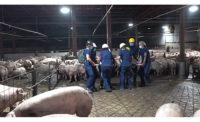USPOULTRY’s Cyber Security and Risk Mitigation Summit focused on safeguarding systems and recovering from attacks
Marcus Sachs echoes the point that ransomware and cybercrime are economically motivated.

USPOULTRY’s Cyber Security and Risk Mitigation Summit welcomed information technology and cyber risk management professionals from across the industry to address the evolving nature of cyber threats. Recent high-profile cyber incidents have shown that it is important for processors to prepare for, and defend against, cyber security threats.
Jeff Shearer, chief automation officer at Morris & Associates, illustrated some of the vulnerabilities present in an industrial environment. As more automation has been integrated into processing plants, feed mills, hatcheries and other production environments, the opportunity for nefarious control of these same systems has increased as well. A key takeaway from Shearer’s presentation was the importance of ensuring that system updates are implemented as soon as possible to prevent the exploitation of vulnerabilities in information and operational technology.
Stewart Ward, vice president of information systems at Koch Foods, related his experiences in the aftermath of a ransomware attack experienced by Koch Foods in 2018. One of the many lessons learned during this incident was that it is crucial to have a business continuity plan that addresses cyber threats. He noted that allocating resources and personnel according to business needs and their own abilities is key to recovering from an attack. He also noted that multi-factor authentication makes systems a much less attractive target. He reminded attendees that in the case of ransomware attacks, the perpetrators are operating a business, and that while paying the ransom may make the immediate issue go away, it does not prevent future issues.
 Jeff Clemons, senior director of internal audits for Mountaire Farms Corporation, one of the speakers at the Cyber Security and Risk Management Summit.
Jeff Clemons, senior director of internal audits for Mountaire Farms Corporation, one of the speakers at the Cyber Security and Risk Management Summit.Jeff Clemons, senior director of internal audits for Mountaire Farms Corporation, spoke about critical asset system classification. Critical assets were defined as those which support essential mission and business functions. Clemons related that classifying assets should be a risk-based approach that incorporates the business continuity plan to prevent business interruption. He reminded attendees of the need to identify technical and operational assets, as both are potentially vulnerable to an attack, and both can have impacts on the organization.
Marcus Sachs, deputy director for research at Auburn University’s McCrary Institute for Cyber & Critical Infrastructure Security, provided some context to how cyber threats have evolved over time from activism and protests to livelihood. He shared that while there used to be a handful of nations playing in this field, lots of counties and groups now have the ability to commit cybercrimes. Sachs echoed an earlier point that ransomware and cybercrime are economically motivated. He remarked that “this is organized crime, and the perpetrators are going to continue to evolve and exploit vulnerabilities until it gets too expensive.”
Source: U.S. Poultry & Egg Association
Looking for a reprint of this article?
From high-res PDFs to custom plaques, order your copy today!







